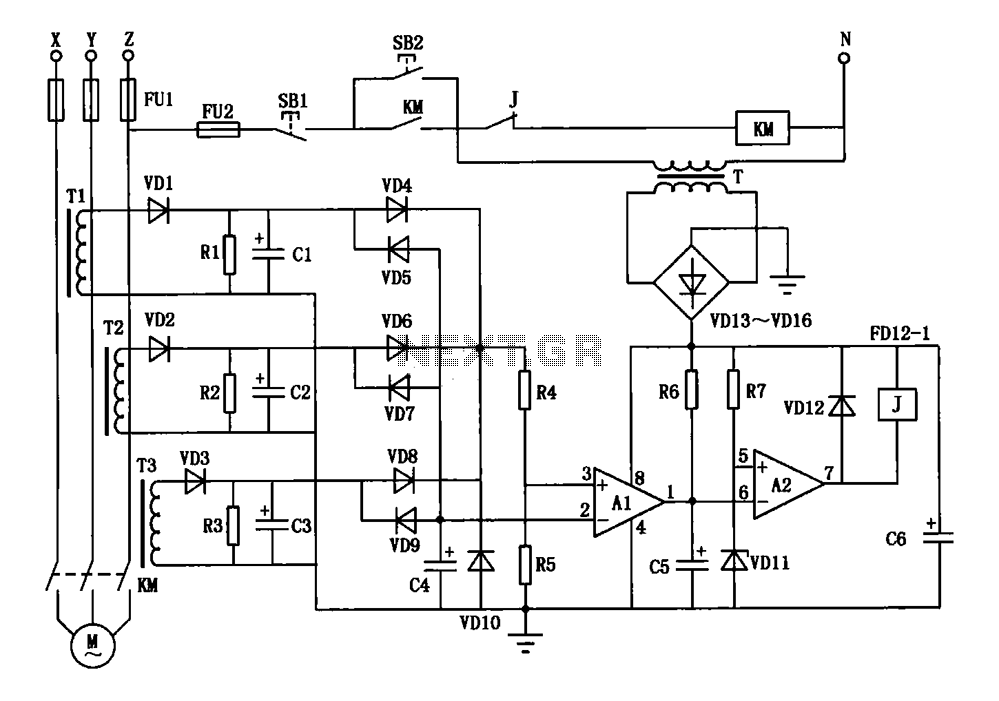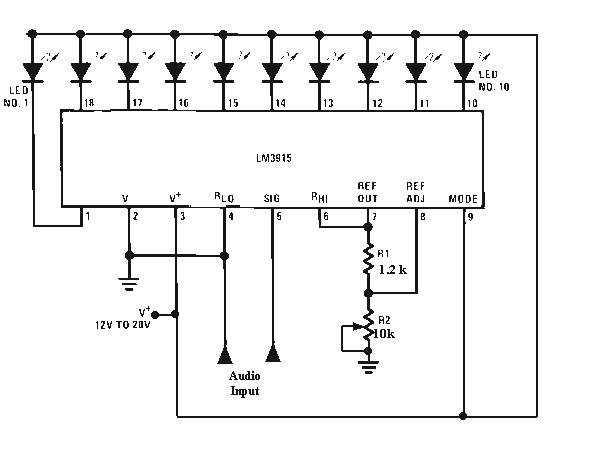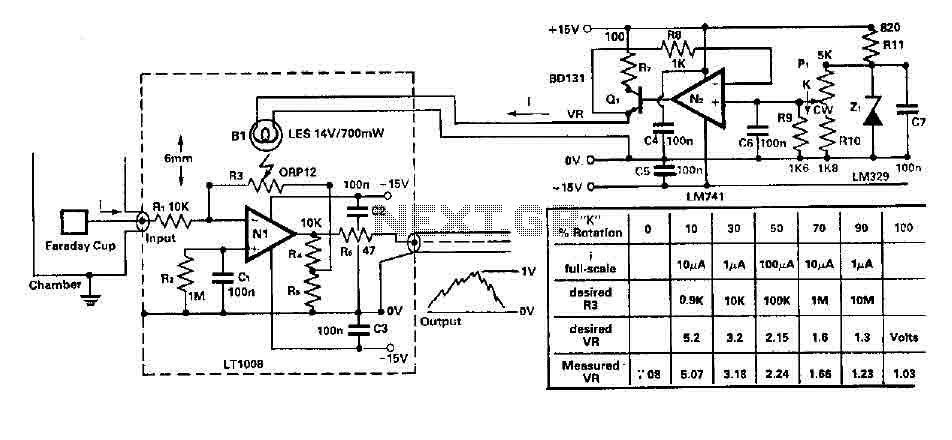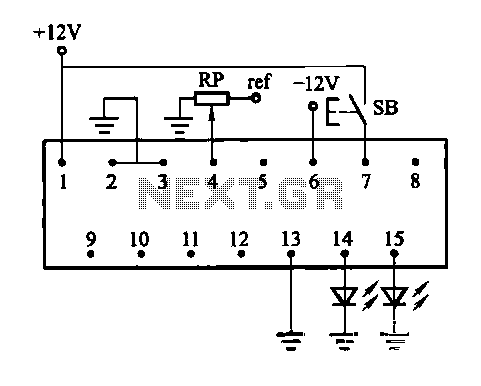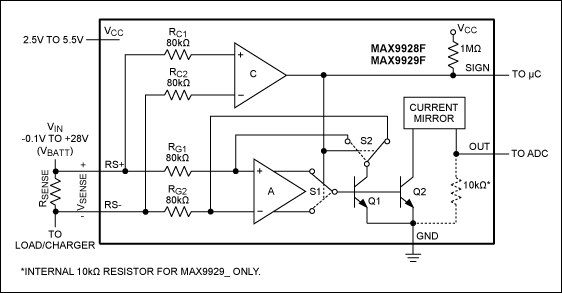
Current Mirror for LEDs
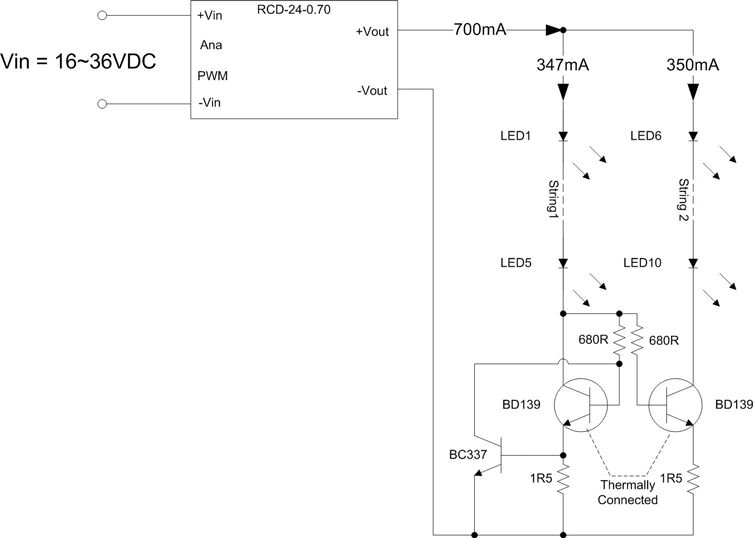
A Meanwell LED driver rated at 27V and 2300mA is available for use, intended to power two parallel strings of six LEDs each. The question arises whether to maintain the existing circuit with the same component values or to adjust the resistor values according to this configuration. The proposed circuit includes a small signal transistor for current monitoring to prevent LED overdriving in the event of LED failures. If the first five LEDs fail open circuit, the current in the second string drops to zero. However, if the last four LEDs fail, the current in the first string increases until the voltage across a 1.5 Ohm emitter resistor reaches approximately 0.7V, activating the BC337 transistor. This action pulls the base voltage of the power transistor to ground, thereby limiting the current. The current limit was measured at 445mA with the second string open circuit. Recommendations include replacing the 1.5 Ohm resistors with approximately 0.47 Ohms, upgrading the BD139 transistors to higher-rated components with a DC current gain over 80 at 1A and a maximum continuous current rating of 2A or more, and potentially reducing the 680 Ohm resistors to 470 Ohms. Concerns regarding efficiency losses with lower gain transistors are noted. If constructed as described, the first string may be limited to around 460mA, while the second string would account for the remaining current (approximately 1840mA), provided there is sufficient headroom to accommodate the increased forward voltage at that current. The circuit is designed to protect the remaining LEDs in the event of a failure, which could incur significant costs. The second iteration of the circuit will maintain the current within the specified range, regardless of which side of the parallel array fails.
The BD139 transistor may encounter difficulties operating at 1150mA, as its gain significantly decreases beyond 400-500mA, potentially dropping to values as low as 8-10 at higher currents. For 1150mA operation with a gain of 10, a base current of 115mA would be required, resulting in a voltage drop across the 680 Ohm resistor of approximately 78V, necessitating either a higher gain transistor or a smaller resistor, or both. Additionally, the behavior of the overcurrent protection circuit must be considered. When the voltage across the 1.5 Ohm resistor exceeds approximately 0.7V, the BC337 begins to conduct, which limits the LED current by increasing the voltage drop across the BD139. The Meanwell driver will attempt to compensate by adjusting its output voltage to maintain the maximum current of 700mA, provided there is sufficient voltage headroom available.
The design of the circuit requires careful consideration of component ratings and values to ensure reliable operation and protection for the LEDs. The use of a higher gain transistor, such as the BC547 or similar, may improve performance under load conditions. Additionally, ensuring adequate heat dissipation for the components, especially the power transistors, is crucial to prevent thermal overload and maintain efficiency. The implementation of a robust current monitoring system can enhance the reliability of the LED strings, safeguarding against potential failures and extending the lifespan of the overall assembly. Proper layout and thermal management techniques should be employed in the PCB design to facilitate optimal performance of the LED driver circuit.I have one Meanwell LED driver of 27V, 2300mA on hand and will be running 2 strings of 6 LEDs in parallel. Should I follow the same circuit with same component value or should I need to change the value of the resistors to my configuration "The addition of a small signal transistor as a current monitor protects the LEDs from being overd
riven in the case of any LED failures. If LED1 LED5 fail open circuit, then the current in the second string falls to zero as before. However, if LED6 –LED10 fail, then the current increases in the first string until the voltage developed across the 1. 5 Ohm emitter resistor reaches around 0. 7V, thus turning on the BC337 transistor and pulling the base voltage of the power transistor to ground and limiting the current.
With the component values given in the circuit, the measured current limit was 445mA with String 2 open circuit. " That circuit will NOT work at 1. whatever amps. Replace the 1. 5s with ~. 47s, the BD139`s with something bigger (anything with a DC current gain over like 80 at 1A and a maximum continuous current of 2A or more) and the 680s maybe drop to 470.
Now that I think about it this circuit kinda sucks, if you get a transistor with a lower end gain its going to eat up a buttload of efficiency. That circuit will NOT work at 1. whatever amps. Replace the 1. 5s with ~. 47s, the BD139`s with something bigger (anything with a DC current gain over like 80 at 1A and a maximum continuous current of 2A or more) and the 680s maybe drop to 470.
Now that I think about it this circuit kinda sucks, if you get a transistor with a lower end gain its going to eat up a buttload of efficiency. If built as shown, string 1 is going to be clamped at 460ma or so, read the blue paragraph as to exactly how.
String 2 is going to take the rest of the current (1840ma or so) assuming there is enough headroom to cover the increased Vf at that current. Ok I take it back the circuit will work in that it lights up all the LEDs. Just make sure you heatsink the crap out of string 2 The point of this circuit is to save the remaining LEDs in the case of a failure.
That could get quite expensive. The second itteration of the circuit on that page will keep either side of the parallel array within the set current range set by the smaller resistor (about 0. 57 ohms to keep the current at no more than 1. 2A), regardless of which side fails. cptbjorn, everyone here is here to learn. If you know that something doesn`t work, educate us as to why and how to fix it, or show us a better way to do it opposed to taking a somewhat condesending tone towards those of use that don`t know.
I won`t say that I know everything. I learn new things every day. Help us learn something new Sorry bro didn`t mean to sound condescending, I just wanted to make sure someone didn`t fry their $$ LEDs. I definitely appreciate all you do around here, I guess I`m just used to my real life where people specifically do NOT want to know the boring nerdy details of how I fix stuff.
Anyways here we go, full version. First of all the BD139 is going to have issues running at 1150ma. While a good device for the original circuit, Its gain drops drastically after 4-500ma and could be as low as 8-10 at 1150ma (down from 80 or so originally). For 1150ma at gain of 10 it will need 1150/10=115ma of base current through the 680 ohm resistor, which equates to a.
115x680=78v! drop. We need a higher gain transistor or a smaller resistor (or both). The second problem is what actually happens when the overcurrent protection kicks in. When the voltage across the 1. 5R resistor goes above ~. 7v, the BC337 starts conducting. This limits the current through the leds by increasing the voltage drop across the left BD139. The Meanwell driver will try to compensate to make the circuit "take" the full 700ma by pegging its voltage output to the maximum it can. If you have 10v of headroom, that BD139 i 🔗 External reference
The BD139 transistor may encounter difficulties operating at 1150mA, as its gain significantly decreases beyond 400-500mA, potentially dropping to values as low as 8-10 at higher currents. For 1150mA operation with a gain of 10, a base current of 115mA would be required, resulting in a voltage drop across the 680 Ohm resistor of approximately 78V, necessitating either a higher gain transistor or a smaller resistor, or both. Additionally, the behavior of the overcurrent protection circuit must be considered. When the voltage across the 1.5 Ohm resistor exceeds approximately 0.7V, the BC337 begins to conduct, which limits the LED current by increasing the voltage drop across the BD139. The Meanwell driver will attempt to compensate by adjusting its output voltage to maintain the maximum current of 700mA, provided there is sufficient voltage headroom available.
The design of the circuit requires careful consideration of component ratings and values to ensure reliable operation and protection for the LEDs. The use of a higher gain transistor, such as the BC547 or similar, may improve performance under load conditions. Additionally, ensuring adequate heat dissipation for the components, especially the power transistors, is crucial to prevent thermal overload and maintain efficiency. The implementation of a robust current monitoring system can enhance the reliability of the LED strings, safeguarding against potential failures and extending the lifespan of the overall assembly. Proper layout and thermal management techniques should be employed in the PCB design to facilitate optimal performance of the LED driver circuit.I have one Meanwell LED driver of 27V, 2300mA on hand and will be running 2 strings of 6 LEDs in parallel. Should I follow the same circuit with same component value or should I need to change the value of the resistors to my configuration "The addition of a small signal transistor as a current monitor protects the LEDs from being overd
riven in the case of any LED failures. If LED1 LED5 fail open circuit, then the current in the second string falls to zero as before. However, if LED6 –LED10 fail, then the current increases in the first string until the voltage developed across the 1. 5 Ohm emitter resistor reaches around 0. 7V, thus turning on the BC337 transistor and pulling the base voltage of the power transistor to ground and limiting the current.
With the component values given in the circuit, the measured current limit was 445mA with String 2 open circuit. " That circuit will NOT work at 1. whatever amps. Replace the 1. 5s with ~. 47s, the BD139`s with something bigger (anything with a DC current gain over like 80 at 1A and a maximum continuous current of 2A or more) and the 680s maybe drop to 470.
Now that I think about it this circuit kinda sucks, if you get a transistor with a lower end gain its going to eat up a buttload of efficiency. That circuit will NOT work at 1. whatever amps. Replace the 1. 5s with ~. 47s, the BD139`s with something bigger (anything with a DC current gain over like 80 at 1A and a maximum continuous current of 2A or more) and the 680s maybe drop to 470.
Now that I think about it this circuit kinda sucks, if you get a transistor with a lower end gain its going to eat up a buttload of efficiency. If built as shown, string 1 is going to be clamped at 460ma or so, read the blue paragraph as to exactly how.
String 2 is going to take the rest of the current (1840ma or so) assuming there is enough headroom to cover the increased Vf at that current. Ok I take it back the circuit will work in that it lights up all the LEDs. Just make sure you heatsink the crap out of string 2 The point of this circuit is to save the remaining LEDs in the case of a failure.
That could get quite expensive. The second itteration of the circuit on that page will keep either side of the parallel array within the set current range set by the smaller resistor (about 0. 57 ohms to keep the current at no more than 1. 2A), regardless of which side fails. cptbjorn, everyone here is here to learn. If you know that something doesn`t work, educate us as to why and how to fix it, or show us a better way to do it opposed to taking a somewhat condesending tone towards those of use that don`t know.
I won`t say that I know everything. I learn new things every day. Help us learn something new Sorry bro didn`t mean to sound condescending, I just wanted to make sure someone didn`t fry their $$ LEDs. I definitely appreciate all you do around here, I guess I`m just used to my real life where people specifically do NOT want to know the boring nerdy details of how I fix stuff.
Anyways here we go, full version. First of all the BD139 is going to have issues running at 1150ma. While a good device for the original circuit, Its gain drops drastically after 4-500ma and could be as low as 8-10 at 1150ma (down from 80 or so originally). For 1150ma at gain of 10 it will need 1150/10=115ma of base current through the 680 ohm resistor, which equates to a.
115x680=78v! drop. We need a higher gain transistor or a smaller resistor (or both). The second problem is what actually happens when the overcurrent protection kicks in. When the voltage across the 1. 5R resistor goes above ~. 7v, the BC337 starts conducting. This limits the current through the leds by increasing the voltage drop across the left BD139. The Meanwell driver will try to compensate to make the circuit "take" the full 700ma by pegging its voltage output to the maximum it can. If you have 10v of headroom, that BD139 i 🔗 External reference
